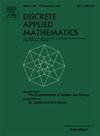Ore-type condition for Hamilton ℓ-cycle in k-uniform hypergraphs
IF 1
3区 数学
Q3 MATHEMATICS, APPLIED
引用次数: 0
Abstract
The classic Ore theorem states that if the degree sum of any two non-adjacent vertices in an -vertex graph is at least , then the graph contains a Hamilton cycle. Tang and Yan extended this result to hypergraphs in 2017 and obtained an Ore-type condition for the existence of tight Hamilton cycles. In this paper, we consider the Ore-type sufficient condition for the existence of Hamilton -cycles. Our main result is that for , , and for sufficiently large with , every -uniform hypergraph on vertices with the degree sum of any two weakly independent sets at least contains a Hamilton -cycle.
k-一致超图中Hamilton -环的ore型条件
经典的Ore定理指出,如果n顶点图中任意两个不相邻顶点的度数和至少为n,则该图包含一个Hamilton循环。Tang和Yan在2017年将这一结果推广到超图上,得到了紧Hamilton环存在的一个ore型条件。本文考虑了Hamilton -环存在的ore型充分条件。我们的主要结果是,当k≥3,1≤r <k/2, γ>;0时,当n足够大且n∈(k−r)n时,每个k-一致超图H=(V,E)在n个顶点上,且任意两个至少为(32(k−r)+γ)n的弱独立集的度和包含一个Hamilton -环。
本文章由计算机程序翻译,如有差异,请以英文原文为准。
求助全文
约1分钟内获得全文
求助全文
来源期刊

Discrete Applied Mathematics
数学-应用数学
CiteScore
2.30
自引率
9.10%
发文量
422
审稿时长
4.5 months
期刊介绍:
The aim of Discrete Applied Mathematics is to bring together research papers in different areas of algorithmic and applicable discrete mathematics as well as applications of combinatorial mathematics to informatics and various areas of science and technology. Contributions presented to the journal can be research papers, short notes, surveys, and possibly research problems. The "Communications" section will be devoted to the fastest possible publication of recent research results that are checked and recommended for publication by a member of the Editorial Board. The journal will also publish a limited number of book announcements as well as proceedings of conferences. These proceedings will be fully refereed and adhere to the normal standards of the journal.
Potential authors are advised to view the journal and the open calls-for-papers of special issues before submitting their manuscripts. Only high-quality, original work that is within the scope of the journal or the targeted special issue will be considered.
 求助内容:
求助内容: 应助结果提醒方式:
应助结果提醒方式:


